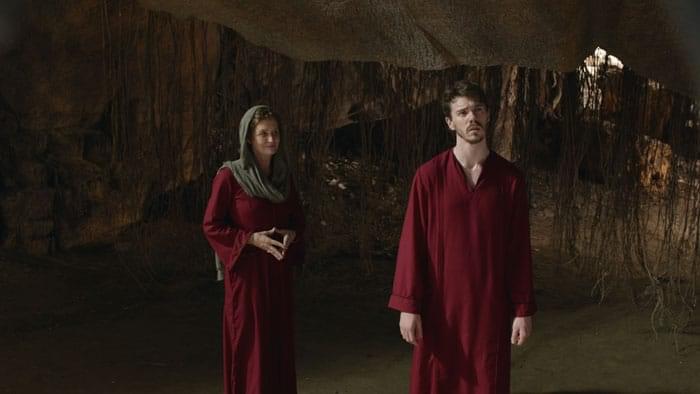
BOOTLEG FILES 168: “Footage of the Last Thylacine” (a 1933 view of the final captive specimen of an extinct Tasmanian marsupial).
LAST SEEN: Available on several Net sites.
AMERICAN HOME VIDEO: None.
REASON FOR DISAPPEARANCE: The 45 seconds of footage has been duped and sliced-and-diced repeatedly over the years.
CHANCES OF SEEING A DVD RELEASE: Sorry, mate.
This week’s column is somewhat different in that the focus is not on a long-lost motion picture classic or a bizarre bit of cult-worthy obscurity. Instead, the film in question is a brief ribbon of celluloid that provides the final glimpse of an animal that fell victim to years of brutal persecution and government-sponsored hunting. The film itself does not have a formal title, and it is called “Footage of the Last Thylacine” just for the sake of temporary identification.
What was a thylacine? It looked like a canine, but it was actually a marsupial that was concentrated in Tasmania. It apparently was also native to the Australian mainland and New Guinea, but it was believed to have disappeared from those land masses before the arrival of the white interlopers (and I emphasize the words “believed to have disappeared” – you’ll see why in a few minutes).
The whites that colonized Tasmania commonly referred to the thylacine as a “Tasmanian tiger,” owing to the stripes on its lower back and its rather startling jaw power (it could extend its lower jaw to a level where it appeared to be perpendicular with its upper jaw). Plus, it was easier to pronounce and spell “tiger” than “thylacine.”
Before the white folks moved in, the Tasmanian Aboriginal population never had a problem with the thylacine. However, the whites that settled Tasmania weren’t comfortable with that ages-old balance of man and nature. First, they wiped out the 5,000-plus Aboriginal population – the last full-blooded Tasmanian Aborigine died in 1876, following decades of genocidal policies. Then it was time to focus on the thylacine.
Despite a lack of evidence that the thylacine posed any danger to the white colonists or the farm animals they brought to Tasmania, the reputation of the thylacine as a danger was planted. From 1888 to 1909, the Tasmanian government paid a bounty of £1 from each thylacine that was shot to death; thylacine puppies generated a bounty of 10 shillings each. By the conclusion of that program, the Tasmanian government paid out 2,184 bounties; it is believed more animals may have been shot but eluded capture and died in the wild.
In the early part of the 20th century, Australia began to enjoy a new revenue source in exporting its exotic wildlife to zoos across North America and Europe. The thylacine was included in this program and many live specimens were captured and shipped overseas. In theory, this should’ve protected the species. Sadly, efforts to breed the thylacine in captivity failed.
Despite repeated warning from scientists that the species faced extinction, the thylacine was hunted recklessly. The last recorded shooting of a wild thylacine took place in 1930. By this point in time, all of the captive thylacines in the foreign zoos had died. As far as anyone cared to determine, one thylacine was known to survive.
In 1933, a young zoologist named David Fleay traveled from Australia to Tasmania to apply for the position of director at the Tasmanian Museum. He didn’t get the job (the museum board was uneasy about having a 27-year-old as director), but while he was in the Tasmanian capital of Hobart he stopped by the city’s zoo. With the permission of the zoo’s management, Fleay was allowed to take a 16mm camera into the enclosure that was home to the zoo’s sole thylacine.
Fleay’s footage is silent and black-and-white, and it only lasts 45 seconds. Yet in its brief, monochromatic silence it offers some of the most tragic footage ever captured on camera.
Fleay captures the thylacine’s wide yawn, which is somewhat unsettling for anyone unfamiliar with the species. But despite the prominent display of jaw power, the thylacine appears to be docile and rather playful. It sniffs the air, paces back and forth, lies down on its side, and even pauses to scratch its fur with a hind leg (not unlike a dog trying to evict an itch). The thylacine is a beautiful animal and it seems incomprehensible that anyone would view it as the vicious killer that required government-sanctioned extermination. Knowing this was the last of its kind makes the footage very hard to comprehend.
Off-camera, the thylacine walked around Fleay and nipped him on his backside. Fleay excused that action as a result of boredom – the thylacine had lived in solitary confinement for years and was clearly attempting to be friendly.
Fleay was genuinely concerned about the thylacine, and with good reason. The under-funded Hobart Zoo was staffed by incompetents who mistreated the animals, to the point of not feeding them and leaving them locked in their outside enclosures in all weather. Fleay’s attempts to have the thylacine transferred to a better-run zoo in Australia were not successful.
In July 1936, Tasmania’s government reversed its long policy of ecological hostility by declaring the thylacine a protected species. The decision had less to do with a newfound love for the thylacine than for economic considerations: foreign zoos were still requesting thylacine specimens but none were to be found.
On September 7, 1936, tragedy struck. The idiots running the Hobart Zoo locked the thylacine out of its sleeping enclosure. The evening was uncommonly cold and the thylacine, already weakened from underfeeding and the stress of solitary captivity, was found dead in the morning.
It took some time before the Tasmanian government realized what it created – and when the truth sank in, there was a considerable change of heart. The Tasmanian government never officially declared the animal extinct, obviously to avoid acknowledging what it created (that designation didn’t come until 1986 when the World Conservation Union made a declaration of official extinction on the 50th anniversary of the Hobart Zoo creature’s death). The thylacine was belatedly honored on the Tasmanian government’s coat of arms and has been incorporated into government tourism marketing materials. Even the Australian government has honored the animal on several commemorative postage stamps.
For years after the death of the Hobart Zoo specimen, people across Tasmanian have claimed to see wild thylacines. Several expeditions, including one led by David Fleay in 1946, have tried to locate surviving thylacines. None were successful. Reportedly, Steve Irwin was planning his own thylacine search before his untimely death last fall.
(As a sidenote: years after the captive thylacine’s death, a man claiming to be a former Hobart Zoo employee stated the animal was called “Benjamin” by its keepers. That man was later exposed as a fake, but the name “Benjamin” is still used in several sources in reference to the animal. I am not identifying the Hobart Zoo specimen by that name since there is no evidence the animal was given that moniker.)
Strangely, thylacine sightings have also occurred in New Guinea and the Australian mainland. Remember what was said earlier: the thylacine disappeared from those areas before the white folks showed up. Evidence that thylacines may still exist in those areas was bolstered in 1973 by ten seconds of 8mm footage shot by Liz and Gary Doyle in South Australia. The Doyles captured the silhouette image of an unidentified canine-type animal running across a road. The blurry nature of the film makes it difficult to positively identify the animal as a thylacine, although the outline of the creature clearly suggests it is not a fox or a feral dog. The Doyles’ footage has been reproduced on several web sites (obviously without the permission of the couple).
As for the Fleay footage, that has been reproduced endlessly and often without authorization (the Tasmanian State Archives claims copyright to it). The footage has been incorporated into several documentaries and museum displays, and it is even available on YouTube (in case you get bored of LonelyGirl15). Some sources, realizing the Fleay footage is on the short side, have spliced additional 15 seconds of footage taken in 1928 from a London Zoo specimen (clearly to offer a longer film viewing experience). For the record, the London footage is of a female thylacine and Fleay’s footage is of a male thylacine (most people obviously can’t tell the difference).
Until such time that a positive identification can be made, we have to consider the thylacine to be extinct. As for the last known thylacine, all we have to remember it by is the 45 seconds of Fleay’s footage – the body of the animal was not preserved. In fact, its fate is too miserable to consider: when the zookeepers discovered the animal died, they responded by taking its body from its open enclosure and throwing it in the trash.
IMPORTANT NOTICE: The unauthorized duplication and distribution of copyright-protected material is not widely appreciated by the entertainment industry, and on occasion law enforcement personnel help boost their arrest quotas by collaring cheery cinephiles engaged in such activities. So if you are going to copy and sell bootleg videos, a word to the wise: don’t get caught. The purchase and ownership of bootleg videos, however, is perfectly legal and we think that’s just peachy! This column was brought to you by Phil Hall, a contributing editor at Film Threat and the man who knows where to get the good stuff…on video, that is.
Discuss The Bootleg Files in Back Talk>>>


The 1973 video is on youtube. Whatever it is, it doesn’t look or move like a canine.
great that you have written about my father’s work with “Benjamin” the Thylacine….David Fleay gave the animal that alias….there were later debates saying my father was wrong and the Thylacine was a female…however he really was a male…..now proved scientifically from the 35 mm movie footage my father took back then. David Fleay took a series of large format still pictures of the last captive Thylacine….well now the movie “The Hunter” is out it shows a “hunter” who actually finds a surviving Thylacine…while the CGI is excellent, the animal is no doubt extinct….maybe we can set the record straight and release a specially made documentary with my father’s original still and movie footage of this beautiful animal.
anyone who likes toi comment my email address is favenchi@yahoo.com
Stephen J Fleay
Java